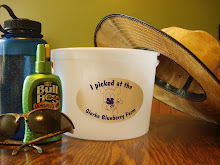The Solar Foundation
We are installing a drip irrigation system for the blueberries. So far we have the well installed, drilled 3 years ago, 140' deep, almost 130' into the Jacobsville Sandstone bedrock. At maximum capacity, the well can produce water at a rate of 30 gallons per minute, but I have chosen a pump that will run off solar power (DC) at a maximum rate of 16 gpm. The solar array will produce a maximum of 180 volts at 8.3 amps, about 1500W. The well and solar array are in the approximate middle of the "Middle Patch". I am going to phase in the drip lines, showing the ones that will be installed for this year in red:
Still a ways off from installing the panels and pump and the irrigation tubing, but I thought I would show the progress to date, which is the foundation for the solar array. The array (6 panels) is going to look approximately like this (screen capture from: http://www.ironridge.com/products/groundmounting/360view):
Working on the frame at the moment, which should look like a smaller version (for 6 panels) of this:
The support structure installation had some vital physical and intellectual help from Ken and Ben and Mieke. Making the poles square to each other and plumb was no easy task. Here is what the supporting structure looks like today (6/23):
We drilled holes for the uprights (3" diameter, SCH 40, galvanized steel pipe) with the tractor and "planted" the poles in the holes about 40" deep and backfilled with Quikcrete. The poles were purchased to be buried 60" and provide a 45 degree tilt. The tractor auger would go down only about 40" and some follow up calculations figured out that the ideal tilt for May-September usage would be about 31 degrees, so the poles were cut after they were installed. Here is a picture of the cutting of the taller (northern) poles. The rope is being used to pull the left pole, which will be cut, towards the right, so as not to pinch the sawblade.
The cutting took place after marking the poles using a string and string-level, then measuring 4.5 feet above the height of the short (southern) poles. After cutting, caps were installed and the cross members placed. Then I checked the level. No adjustments were made and this is for the cross member on the tall poles (7 ft above the ground):
I was pretty surprised by how level this was. Well, to be honest, here is the level on the shorter (easier) poles:
More to come.
Oh, by the way, two weeks into blossoming of the blueberries, which follow the blossoming of apples. Probably late this year.



















